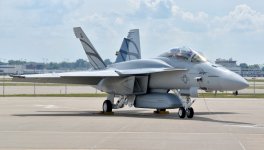Boeing Execs Confident of Turnaround as Jet Fighter Production Slows
The Boeing Co. is hoping that upgrades and international sales of its legendary F/A-18E and F-15 aircraft — as well as an upcoming Air Force trainer program — will keep its jet fighter production lines humming well into the next decade, company executives said Sept. 12.
Despite dwindling production of the F/A-18E Super Hornet and EA-18G Growler in recent years, the company is “very confident” that it would continue to produce aircraft for the domestic services and international customers into the 2020s, said Dan Gillian, Boeing vice president and F/A-18 program manager.
“Two years ago, we would have ended production in 2016,” he said. “Now, we’re optimistic about a bright future … well into the next decade.”
The company plans to recommend a series of upgrades for the Navy’s Advanced Super Hornet and Growler fleets and the Air Force’s F-15 Eagle fleet that would extended their ranges and add capabilities to combat emerging threats, Gillian said.
These include the Super Hornet service life extension program, which aims to extend the planes from 6,000 hours of service to over 9,000 miles, he said…
Boeing is currently producing two Super Hornets per month at its St. Louis facilities, but that could change with new U.S. and international orders, Gillian said. Boeing is in discussions at various levels with international customers including Kuwait, Australia and India to buy the Super Hornet, he added [emphasis added.
The company announced Sept. 15 that it would formally challenge the Danish Ministry of Defence's choice to procure Lockheed Martin's F-35 Lightning II for its future fighter jet, rather than the Super Hornet...
“Super Hornets and Growlers will be flying alongside F-35s into the 2040s [emaphasis added, with USN]…”‘
http://www.nationaldefensemagazine.org/blog/Lists/Posts/Post.aspx?ID=2300




